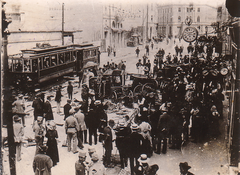Anti-Serb riots in Sarajevo

A crowd gathered around piles of destroyed Serb property in Sarajevo, 29 June 1914
|
|
| Date | 28–29 June 1914 |
|---|---|
| Location | Sarajevo, Bosnia and Herzegovina, Austria-Hungary |
| Coordinates | 43°52′00″N 18°25′00″E / 43.8666°N 18.4166°ECoordinates: 43°52′00″N 18°25′00″E / 43.8666°N 18.4166°E |
| Also known as | Sarajevo frenzy of hate |
| Cause | Anti-Serb sentiment in the aftermath of the assassination of Archduke Franz Ferdinand |
| Participants | Bosnian Muslim and Croat population in Sarajevo, encouraged by the Austrian authorities |
| Deaths | 2 Serbs killed |
| Property damage | Numerous houses and buildings owned by Serbs |
| Inquiries | More than 100 Serbs arrested on suspicions of supporting the assassins of Franz Ferdinand 58 non-Serbs arrested |
The anti-Serb riots in Sarajevo consisted of large-scale anti-Serb violence in Sarajevo on 28 and 29 June 1914 following the assassination of Archduke Franz Ferdinand of Austria. Encouraged by the Austro-Hungarian government, the violent demonstrations assumed the characteristics of a pogrom, leading to ethnic divisions unprecedented in the city's history. Two Serbs were killed on the first day of the demonstrations, and many were attacked, while numerous houses, shops and institutions owned by Serbs were razed or pillaged.
In the aftermath of the assassination of Archduke Franz Ferdinand of Austria by Bosnian Serb student Gavrilo Princip, anti-Serb sentiment ran high throughout Austria-Hungary, resulting in violence against Serbs. On the night of the assassination, country-wide anti-Serb riots and demonstrations organized in other parts of the Austro-Hungarian Empire took place, particularly on the territory of modern-day Bosnia and Herzegovina and Croatia. As Princip's co-conspirators were mostly ethnic Serbs, the Austro-Hungarian government soon became convinced that the Kingdom of Serbia was behind the assassination. Pogroms against ethnic Serbs were organized immediately after the assassination and lasted for days. They were organized and stimulated by Oskar Potiorek, the Austro-Hungarian governor of Bosnia and Herzegovina. The first anti-Serb demonstrations, led by the followers of Josip Frank, were organized in early evening of 28 June in Zagreb. The following day, anti-Serb demonstrations in the city became more violent and could be characterized as a pogrom. The police and local authorities in the city did nothing to prevent anti-Serb violence.
...
Wikipedia
